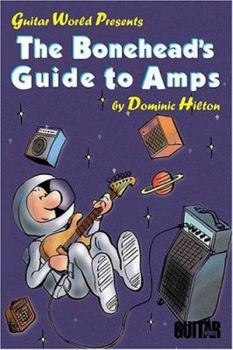The Bonehead's Guide to Amps
Select Format
Select Condition 
Book Overview
For many novice players their amp is the boring, functional part of their first set-up. This guide explains how it can be as exciting, inspirational and as important as their guitar. Viewing the amp as an instrument in its own right, this book defines both the fundamental and subtle differences between many types of amplifier, while offering valuable info on "tone-tweaking" every kind to suit different styles. Learn how to adjust your amp for a whole...
Format:Paperback
Language:English
ISBN:0793598001
ISBN13:9780793598007
Release Date:February 2000
Publisher:Hal Leonard Publishing Corporation
Length:80 Pages
Weight:0.30 lbs.
Dimensions:0.2" x 6.0" x 9.0"
Customer Reviews
2 ratings
amps basics
Published by Thriftbooks.com User , 15 years ago
this is a small book dedicated to explain all the basic information about guitar amps, very educational. later when you read it well, you can move to more complex material like the tom mitchell book.
OK first-generation amp tone/rig setup book
Published by Thriftbooks.com User , 21 years ago
Mentions guitar speaker distortion on page 20, portraying power amp and speaker distortion as "an essential ingredient for guitar amps".Mentions "amplifier circuitry and speaker overload", p 22. Page 26 mentions power amp distortion, and a power mode (1/2-power) switch, and shows a photo of the Marshall PowerBrake: "Powerbrake, which is a heavy-duty volume control capable of absorbing the power of a flat-out amp to deliver the same tone at a lower volume..." This is the ideal, not the reality; many people hold that the THD Hot Plate is more transparent than the Marshall PowerBrake, but both products have a characteristic EQ response that manifests even with just a few dB of attenuation, and in addition, heavy attenuation inherently drives the guitar speaker differently, with less roundness and complexity, and this in turn affects the power-tube response. It's odd that the author doesn't mention the Hot Plate, which is often favored over the PowerBrake, given that page 61 shows a photo of a guitarist (Carl V.?) with gear that includes a THD Hot Plate, low in the rack, behind the mic stand.The book doesn't mention other solutions to the loudness problem including London Power's Power Scaling, the Peale Power Sag technology, and speaker isolation cabinets, and doesn't mention that the power reduction switch is 1/4-power on many amps, nor does it propose using truly low-wattage tube power amps such as 5 watts down to a fraction of a watt.Page 76 mentions the problem of integrating a guitar preamp/processor with a tube amp, but doesn't have any specific advice; it leaves the reader dangling with a vague recommendation to do "judicious reprogramming" and "serious tweaking and comparisons", rather than providing useful insight and practical guidance.From the start, this series makes a potentially fatal mistake of separating without integrating guitars, amps, and effects. The "getting guitar sounds" books make more sense for those whose goal is to look at the combination of guitar, amp, and effects as a way of producing a target sound. How does a single-coil neck pickup, through a slow phaser, into a distorted tube power amp sound?






